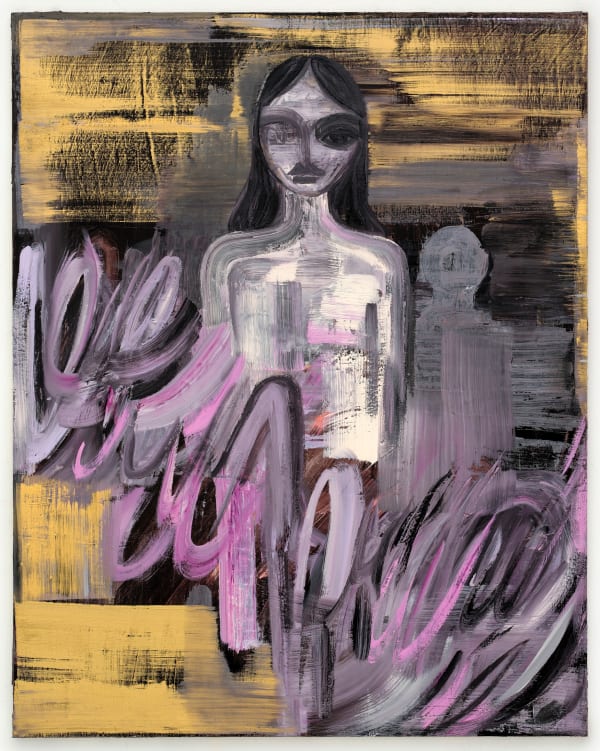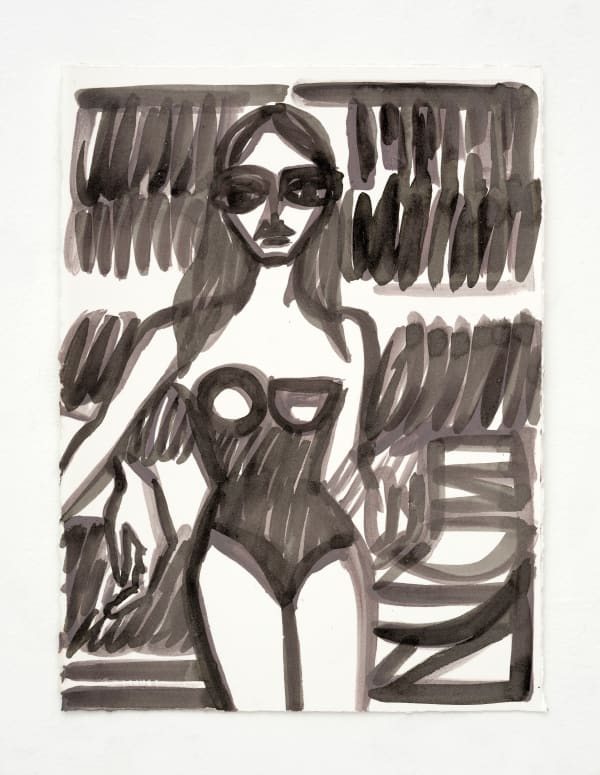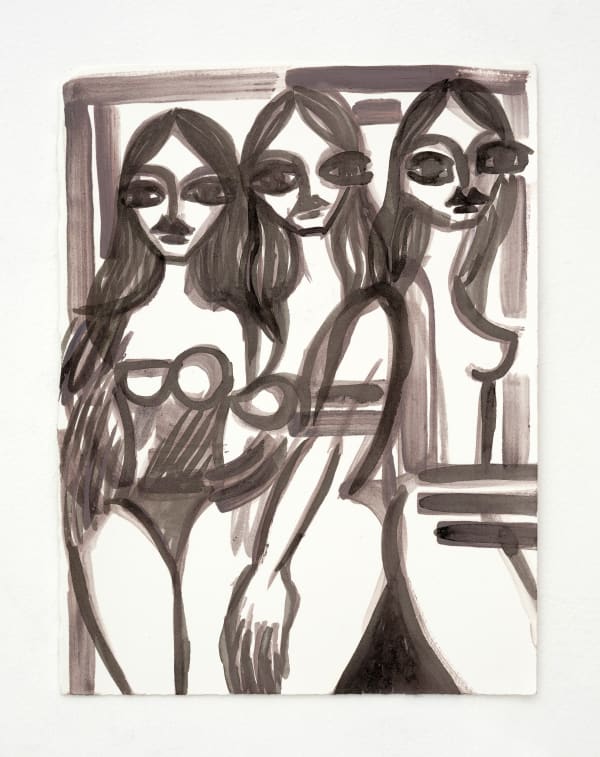-
-
 Natasha WrightMain Character, 2025Oil on canvas1220 x 1525 mm$ 14,900.00
Natasha WrightMain Character, 2025Oil on canvas1220 x 1525 mm$ 14,900.00 -
 Natasha WrightBias cut, 2025Oil on canvas1220 x 1525 mmSold out
Natasha WrightBias cut, 2025Oil on canvas1220 x 1525 mmSold out -
 Natasha WrightSilver Sirens, 2025Oil on canvas1220 x 1525 mmSold out
Natasha WrightSilver Sirens, 2025Oil on canvas1220 x 1525 mmSold out -
 Natasha WrightShe left no crumbs, 2025Oil on canvas1220 x 1525 mm$ 14,900.00
Natasha WrightShe left no crumbs, 2025Oil on canvas1220 x 1525 mm$ 14,900.00 -
 Natasha WrightSnatched for the Gods, 2025Oil on canvas920 x 1220 mm$ 12,000.00
Natasha WrightSnatched for the Gods, 2025Oil on canvas920 x 1220 mm$ 12,000.00 -
 Natasha WrightWaist –deep, 2025Oil on canvas1525 x 1780 mm$ 19,900.00
Natasha WrightWaist –deep, 2025Oil on canvas1525 x 1780 mm$ 19,900.00 -
 Natasha WrightRib Cage, 2025Oil on canvas1220 x 1525 mm$ 14,900.00
Natasha WrightRib Cage, 2025Oil on canvas1220 x 1525 mm$ 14,900.00 -
 Natasha WrightHandful, 2025Oil on canvas920 x 1220 mm$ 12,000.00
Natasha WrightHandful, 2025Oil on canvas920 x 1220 mm$ 12,000.00 -
 Natasha WrightGirl, Girl, Girl, 2025Oil on canvas1678 x 1830 mm$ 23,900.00
Natasha WrightGirl, Girl, Girl, 2025Oil on canvas1678 x 1830 mm$ 23,900.00 -
 Natasha WrightMain Character II, 2025Oil and ink on paper, framed280 x 381 mm$ 3,100.00
Natasha WrightMain Character II, 2025Oil and ink on paper, framed280 x 381 mm$ 3,100.00 -
 Natasha WrightMain Character III, 2025Oil and ink on paper, framed280 x 381 mm$ 3,100.00
Natasha WrightMain Character III, 2025Oil and ink on paper, framed280 x 381 mm$ 3,100.00 -
 Natasha WrightMain Character IV, 2025Oil and ink on paper, framed280 x 381 mm$ 3,100.00
Natasha WrightMain Character IV, 2025Oil and ink on paper, framed280 x 381 mm$ 3,100.00 -
 Natasha WrightMain Character V, 2025Oil and ink on paper, framed280 x 381 mm$ 3,100.00
Natasha WrightMain Character V, 2025Oil and ink on paper, framed280 x 381 mm$ 3,100.00 -
 Natasha WrightMain Character VI, 2025Oil and ink on paper, framed280 x 381 mm$ 3,100.00
Natasha WrightMain Character VI, 2025Oil and ink on paper, framed280 x 381 mm$ 3,100.00
-
-
Press Release
Opening - Wednesday October 15th, 6-8pm
Sanderson are pleased to present the exhibition Main Character featuring a new body of work by Natasha Wright.
‘A Siren of Her Time’
Natasha Wright’s Main Character
by Evangeline Riddiford Graham
Hinepūkohurangi, descending with the mist and gathering her diffuse particles into the confines of a maiden's body. The snow woman, wrapped in the white kimono that contains—and conceals—a blizzard. The selkie on the rocks, who slides in and out of her velvet sealskin.
In Natasha Wright's latest series of paintings exploring the female form, the painted heroine shares this same uncanny quality of fulfilling the prophecy of her origins. Wright has enriched her base layer of paint with sediment collected from her used brushes and paint cans, resulting in a rich, enigmatic grey. This means that the fundamental matter of Wright's painted woman—the equivalent of her mist, snow or fur—is the memory of all the other painted women who have come before. Break her down into the smallest components, and you'll find not paint but the history of the female form on canvas.
For her new exhibition at Sanderson (15th October – 9th November) Wright has chosen the apt title ‘Main Character’. The phrase gestures toward a narrative in which the fantastic woman—rather than the fishermen and warriors who desire her company—is the protagonist of her own myth; it also hints at the role of the internet in determining the form she takes today. Wright's subject, clad in a thong or a bodysuit and claiming center stage, is giving main character energy. She'snothing if not a siren of her time.
Main Character brings together nine large canvases, each featuring a three-quarter portrait of at least one sinuous, half-emerged woman—half-emerged from her clothing but also half-emerged from paint. Loosely delineating her heroine against a luxurious swirl of grey, purple, and silver, Wright emphasizes the interchangeability between the ideal woman and the physical and cultural history that shapes her long hair and lovely waist.
Wright’s work participates in a still-unfolding conversation about figuration that spans mid-twentieth-century artists such as Willem De Kooning and Francis Bacon and contemporary artists like Mira Dancy and Cristina BanBan. What does it mean for a portrait to focus on the form of a subject’s body rather than the identifying features of a face? In what sense might that approach be more true? For Wright, Dancy, and BanBan, that question is particularly applicable to the female nude. When Wright blurs, simplifies, or partially erases a female face, it’s not to deny her subject’s personhood but to emphasise a sense of self that exists beyond the particularities of individual appearance.
Wright's main character, when she turns to the mirror, already knows perfectly well what she looks like. What she wants to see is what it feels like to physically inhabit her own image. In the modern online world of user-produced, dematerialized, and instantaneous spectacle that artists like Wright are navigating, it's the female subject’s somatic experience, rather than the self-consciousness of her performance, that's most uncertain.
She experiences that arrival into flesh as thoroughly delicious. In response to isolated sensory experiences—the feeling of walking waist-deep in water, of wearing a bias-cut silk dress—Wright's women radiate what the artist thinks of as "energetic lines" of self-knowledge. Taking inspiration from Rodin's figure drawings, in which models seem to vibrate between one position and the next, Wright surrounds these new women with brushstrokes that describe sensation in terms of motion: sweeping calligraphic strokes and massive horizontal swipes of aluminium and violet. In one of the exhibition's most poignant moments, two women sit so close their legs seem to merge, creating a silver heart shape of knee-to-shin physical contact that, once you see it, becomes the painting's centre of consciousness.
For Wright, the main character's humanity is located in her body—a proposition that unfortunately feels newly radical in 2025, a time when a woman's right to choice and self-determination is under threat in the United States, where Wright lives and works. Seen through one eye, Wright's heroines are retreating into the history of paint, just as a maiden returns to her original form—snowstorm, seal or mist. Open your other eye, and Wright's strange, celebratory women are in a process of becoming, their pigment coalescing into the shape of a goddess who offers her hand.
Current viewing_room
Newsletter
* denotes required fields
We will process the personal data you have supplied to communicate with you in accordance with our Gallery Accessibility & Privacy Policy. You can unsubscribe or change your preferences at any time by clicking the link in our emails.













